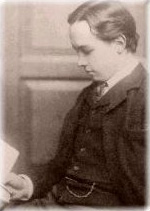 |
| Billy Bishop and Margaret Burden, 1917 |
As a teenager growing up in Owen Sound, Billy Bishop was pretty popular with the ladies. His little sister's friends would beg her to convince him to go out with them — and he'd agree... every time his sister was willing to pay him $5. One of those friends was a pretty girl from Toronto, Margaret Burden. She was the granddaughter of super-rich department store guy Timothy Eaton and her family didn't approve of the middle-class Bishop, but that didn't stop him. He fell in love at first sight and went home that night to tell his parents that he had met the girl he was going to marry.
But before he had a chance to work up to a proposal, he found himself fighting the First World War. And things quite literally didn't get off to a flying start. He was stationed in England with a cavalry unit, miserable on the ground in the rain and the mud. After a few weeks of it, he requested a transfer to the Royal Air Force; the average life expectancy for a rookie pilot was only 11 days, but as Bishop put it: "I'll bet you don't get any mud or horseshit on you up there. If you die, at least it would be a clean death."
As it turned out, he wasn't even a very good pilot. In fact, he sucked. On his first mission, he narrowly avoided getting shot down and was separated from the rest of his squadron. His commanders decided they were going to send him back to flight school just as soon as they could find a replacement.
But he was an incredible shot. In his first real battle, he downed a German ace who had destroyed 12 Allied planes. And even though he lost an engine in the process — crashing into no man's land and scrambling back across the line — the very next day, Bishop went back up and shot down another one. Before long, he was heading out alone on his own unofficial runs, and in just over a week, he had claimed his fifth victory, earning him the title of "ace" and getting the nose of his plane painted blue in celebration. Over the next few months, he would shoot down dozens more, face off against Germany's famous Red Baron, win the Victoria Cross, and find himself holding the record for downing more enemy planes than any other pilot in the Royal Flying Corps.
By the time he headed home on leave in the fall of 1917, he was an international celebrity, one of the most famous pilots in the world. In October, at Timothy Eaton Memorial Church on St. Clair just east of Spadina, he and Margaret finally got married in front of a huge crowd of family, friends and fans.
Of course, the story is much more romantic if you skip over a few details. Like the mistress Bishop kept in France. Or just how much the war had messed him up. "You have no idea how bloodthirsty I've become," he wrote in a letter to the love of his life, "and how much pleasure I get in killing Huns." After one battle, he apparently tried to bring back a German corpse as a trophy. His enemies started calling him "Hell's Handmaiden" and "The Blue Nosed Devil"; one fighter squadron put a bounty on his head.
But back home, he was a hero. And as he kept racking up victories, the Canadian government started to worry about what would happen to the country's morale if he were ever killed. So they pulled him out of action and ordered him back to England. Bishop was seriously pissed off. On his last day, he ran one final solo mission, downing five more planes in 15 minutes. It gave him a total of 72, making him the third most successful ace of the First World War — just eight victories behind the Red Baron himself.
















